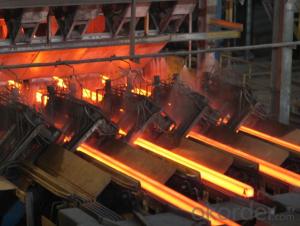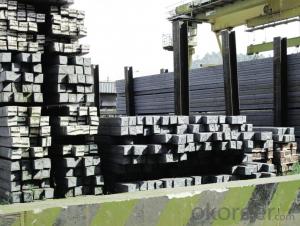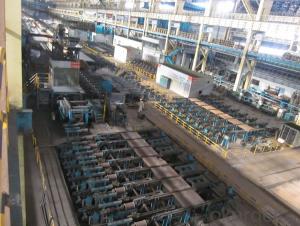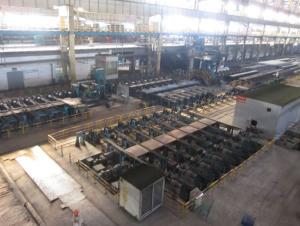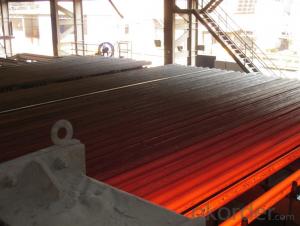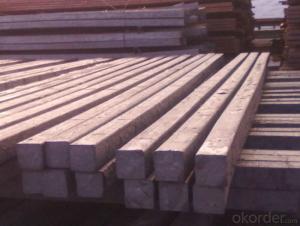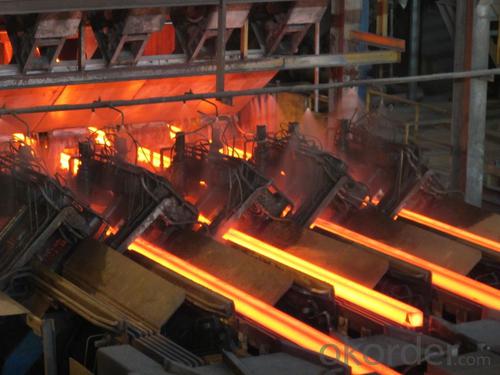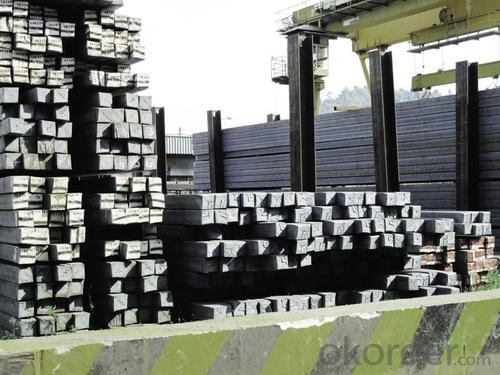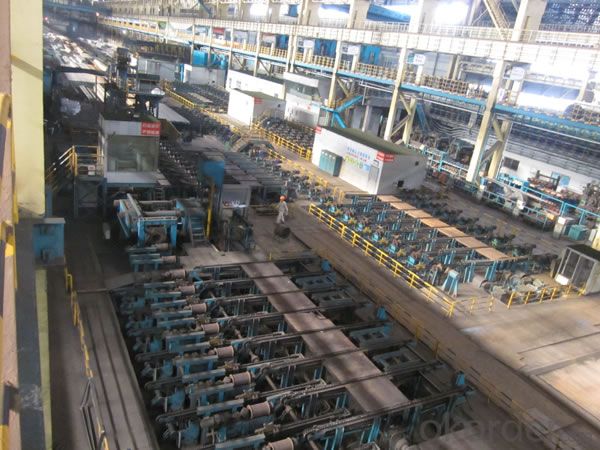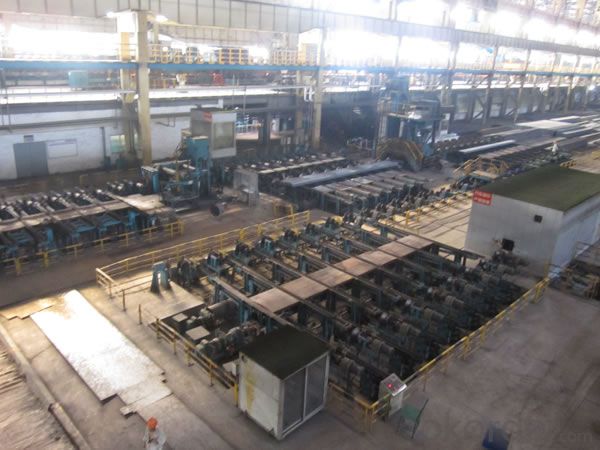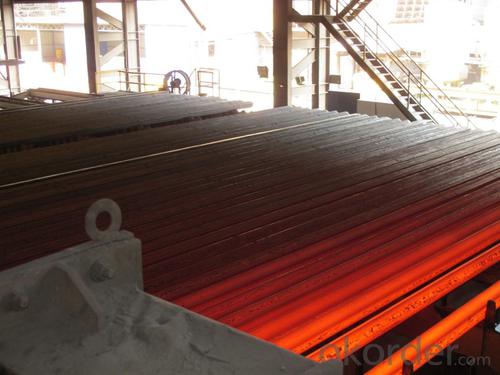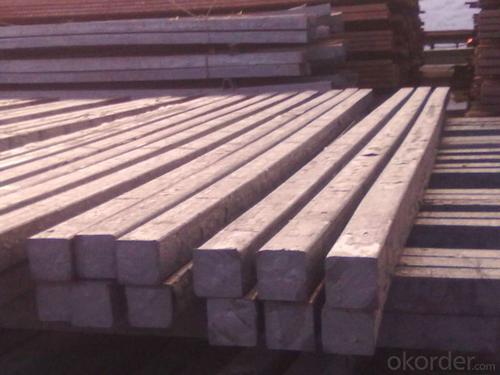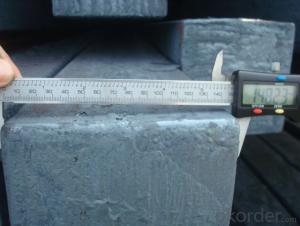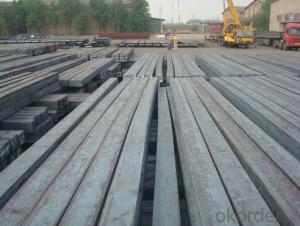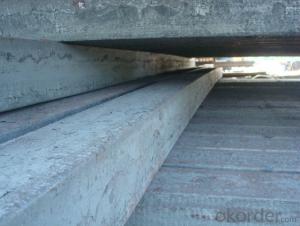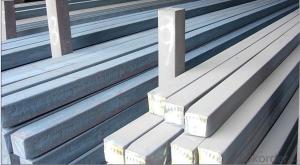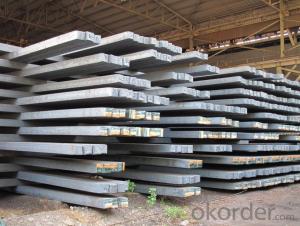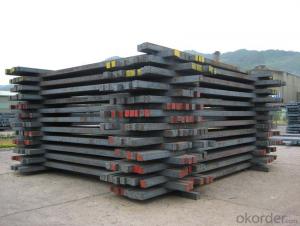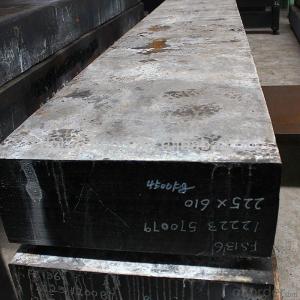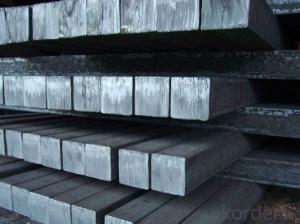Square Steel Billet Q235 Grade Prime Quality 2#
- Loading Port:
- Tianjin
- Payment Terms:
- TT OR LC
- Min Order Qty:
- 2000 m.t
- Supply Capability:
- 50000 m.t/month
OKorder Service Pledge
OKorder Financial Service
You Might Also Like
Description of Square Steel Billet Q235 Grade Prime Quality 2#
M. S. Billets are used for rolling of TMT Re-Bars of Fe415 and Fe500 Grade and various other structural steel products.
CRS Billets are used for rolling of CRS TMT Re-Bars.
Special Alloy Billets are used for rolling of any special grade TMT Re-Bars like Earthquake resistant TMT Re-Bars and for special grade structural steel products.
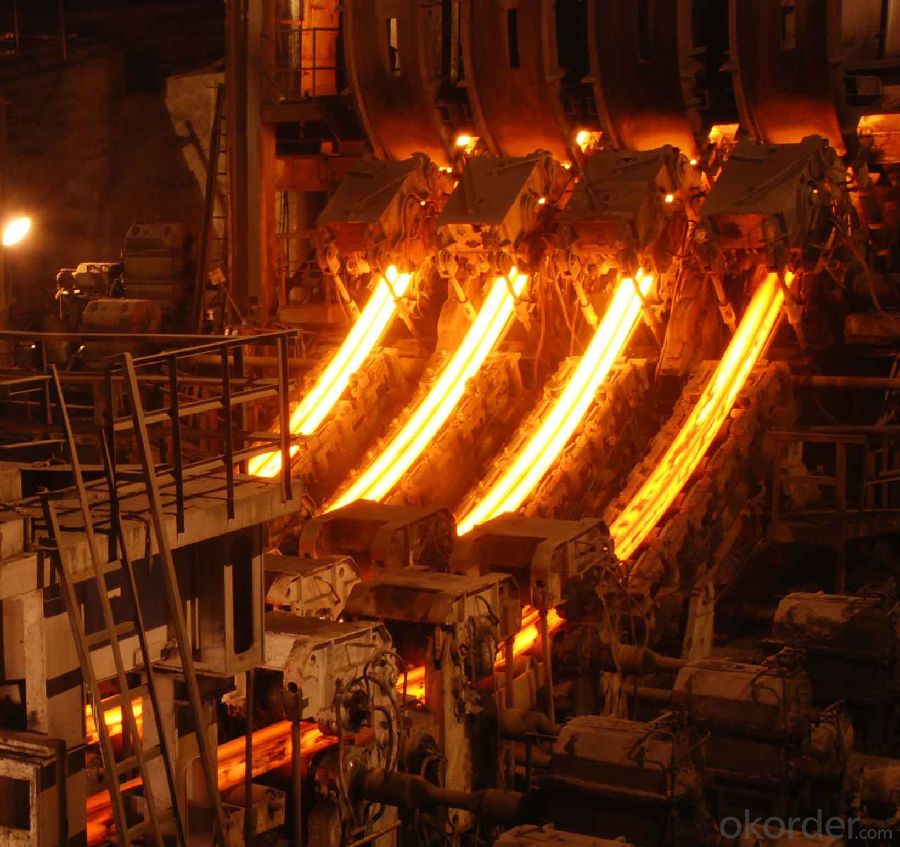
Main Feature Square Steel Billet Q235 Grade Prime Quality 2#
Raw elements(C,Fe,Ni,Mn,Cr,Cu.)---Smelted ingots by AOD finery---hot rolled into black suface---pickling in acid liquid---cold drawn----polished by automatically machine--- cutting into pieces---checking quanlity
Applications of Square Steel Billet Q235 Grade Prime Quality 2#
Widely Used in the areas such as Stainless Steel Fasteners, Chains, Kitchen and Sanitary wares, Furniture handles, Handrails, Electroplating and Electrolyzing pendants, Foods, Electron, Petroleum, Construction and Decoration, etc. Products have a high strength after cold-working. Electronic products parts, Medical appliance, Springs, Bus Inside and Outside packaging and building, Street Lamp Posts, etc. Decoration materials and Outdoor Publicity Billboard. Used for the products which have the Anti-Stress Corrosion requirement. Electron Products, Table-wares, Bolts, Nuts, Screen Meshes, Cumbustors and so on.
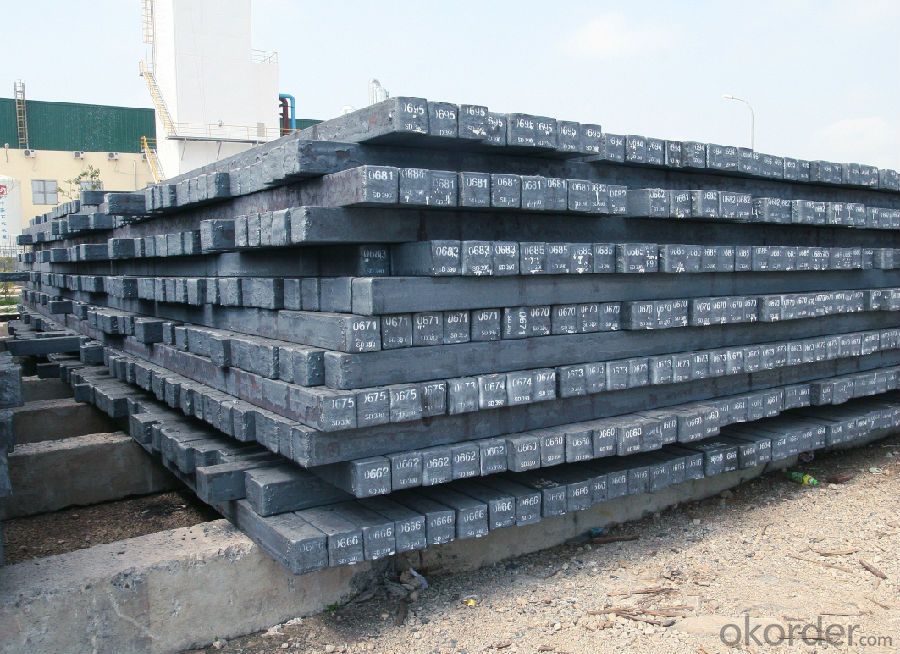
Specifications of Square Steel Billet Q235 Grade Prime Quality 2#
| Standard | C(%) | Mn(%) | S(%) | P(%) | Si(%) |
| Q195 | ≤0.12 | ≤0.50 | ≤0.040 | ≤0.035 | ≤0.30 |
| Q235 | ≤0.20 | ≤1.40 | ≤0.045 | ≤0.045 | ≤0.35 |
| Q275 | ≤0.22 | ≤1.50 | ≤0.045 | ≤0.045 | ≤0.35 |
| 20MnSi | 0.17-0.25 | 1.2-1.6 | ≤ 0.050 | ≤ 0.050 | 0.40-0.80 |
| 3SP | 0.14-0.22 | 0.40-0.85 | ≤ 0.050 | ≤ 0.040 | 0.05-0.15 |
| 5SP | 0.28-0.37 | 0.50-1.00 | ≤ 0.050 | ≤ 0.040 | 0.15-0.30 |
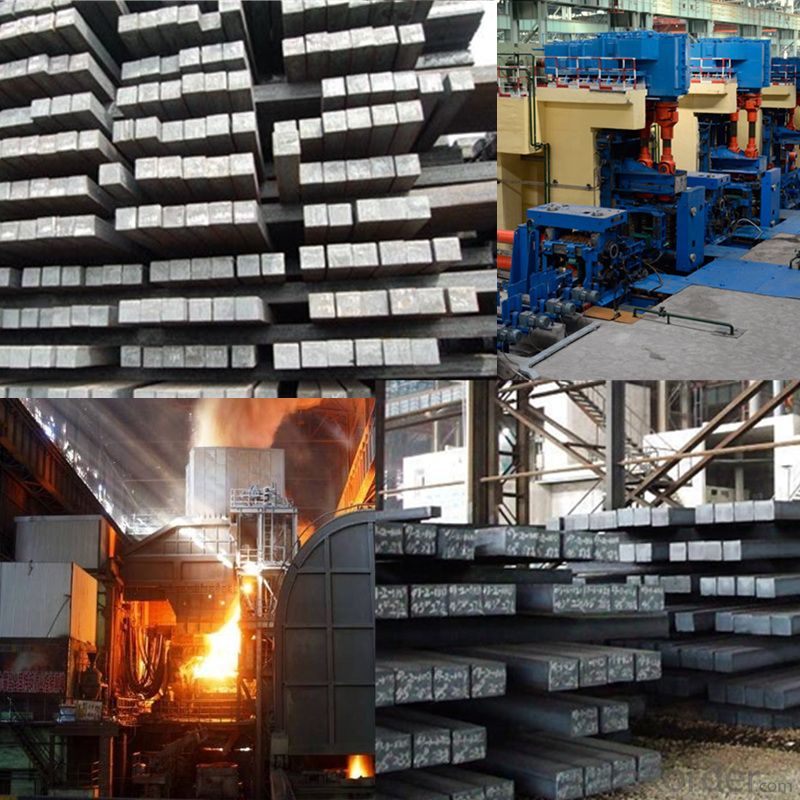
FAQ of Square Steel Billet Q235 Grade Prime Quality 2#
We have organized several common questions for our clients,may help you sincerely:
1. How Can I Visit There?
Our company is located in Tianjin City, China, near Beijing. You can fly to Tianjin Airport Directly. All our clients, from home or aboard, are warmly welcome to visit us!
2. How Can I Get Some Sample?
We are honored to offer you sample.
3. Why choose CNBM?
Our delivery time about 15-20days for standard sizes, if you have other requirements like hardness, quanity and width ,it is about 20-40days. But don't worry we also try our best for the delivery time ,because time longer and our cost is higher.
- Q: What are the potential applications of steel billets in the medical industry?
- Steel billets have a wide range of potential applications in the medical industry. One potential application is in the manufacturing of surgical instruments. Steel billets can be shaped and machined into various surgical tools such as scalpels, forceps, and scissors. The high strength and durability of steel make it an ideal material for these instruments, ensuring their longevity and reliability in surgical procedures. Another potential application of steel billets in the medical industry is in the production of medical implants. Steel billets can be processed and formed into implants like joint replacements, spinal implants, and dental implants. The biocompatibility of steel, combined with its strength and resistance to corrosion, makes it a suitable material for implants that need to withstand the body's environment and provide long-term support. Moreover, steel billets can be utilized in the construction of medical equipment and machinery. Steel is commonly used in the manufacturing of medical beds, surgical tables, and imaging devices like MRI machines and X-ray equipment. The structural integrity and stability of steel make it an excellent choice for these applications, ensuring the safety and functionality of medical equipment. Additionally, steel billets can be employed in the production of medical furniture and storage units. Steel cabinets and shelves are commonly used in medical facilities to store equipment, supplies, and medications. The strength and durability of steel ensure that these storage solutions can withstand the rigorous demands of the healthcare environment. In summary, the potential applications of steel billets in the medical industry are vast and diverse. From surgical instruments and medical implants to equipment and furniture, steel's properties make it a valuable material for enhancing the quality and effectiveness of healthcare products and facilities.
- Q: Can steel billets be used in the production of energy-efficient appliances?
- Yes, steel billets can be used in the production of energy-efficient appliances. Steel is a versatile and durable material that can be formed into various components of appliances, such as shells, frames, and internal structures. When properly designed and manufactured, steel components can contribute to the overall energy efficiency of appliances by ensuring better insulation, heat distribution, and overall performance.
- Q: How do steel billets differ from steel bars?
- Steel billets and steel bars, two intermediate steel products utilized in various industries for further processing, exhibit distinct differences. 1. Shape: Steel billets typically assume square or rectangular shapes, with cross-sectional dimensions ranging from a few inches to several feet. They are typically manufactured through continuous casting or hot rolling procedures. Conversely, steel bars adopt cylindrical shapes and maintain a uniform diameter throughout their length. They are usually produced through hot rolling or cold drawing processes. 2. Size: Steel billets tend to be larger compared to steel bars. Billets can measure from a few feet to several meters in length, while their cross-sectional dimensions can be customized based on the final product's requirements. Conversely, steel bars are typically manufactured in standardized sizes and lengths, such as 6 meters or 12 meters, and possess consistent diameters. 3. Production process: Steel billets are commonly generated through continuous casting or hot rolling methods. Continuous casting involves pouring molten steel into a mold, resulting in a solid billet. Hot rolling, on the other hand, entails passing the billet through multiple rollers to reduce its cross-sectional dimensions. In contrast, steel bars are produced through hot rolling or cold drawing processes. Hot rolling involves guiding billets through a series of rollers to achieve the desired shape and size, while cold drawing requires pulling the hot rolled bars through a die to further reduce their diameter and enhance their surface finish. 4. Applications: Steel billets primarily serve as raw materials for subsequent processing into various steel products, such as bars, rods, wires, and tubes. Additionally, they find application in the forging industry for the production of forged components. Steel bars, in contrast, enjoy a wide range of applications in construction, manufacturing, infrastructure, and automotive industries. They are commonly employed as reinforcement in concrete structures and in the production of shafts, gears, axles, and other machine parts. To summarize, steel billets and steel bars differ in terms of shape, size, production process, and applications. Billets, with their larger size and square or rectangular shape, serve as raw materials for further processing. Meanwhile, bars, with their cylindrical form and consistent diameter, find application in various industries for specific purposes.
- Q: How are steel billets stored to prevent corrosion?
- In order to prevent corrosion, steel billets are typically stored in a manner that avoids direct contact with moisture and oxygen, which are the primary culprits. One common approach involves keeping the billets indoors in a controlled environment, such as a warehouse or storage facility. These facilities are specially designed to maintain low levels of humidity and often feature climate control systems for temperature and moisture regulation. To provide further protection against corrosion, steel billets can be placed on wooden pallets or racks. This ensures that they are kept away from the ground and any potential sources of moisture. Additionally, it is customary to apply a protective coating or oil film on the surface of the billets before storing them. This coating acts as a barrier, preventing moisture and oxygen from directly contacting the steel and reducing the risk of corrosion. Regular inspections and maintenance are crucial to promptly identify and address any signs of corrosion. This may involve periodic cleaning, applying additional protective coatings, or implementing other preventive measures as needed. By storing steel billets in a controlled environment, applying protective coatings, and conducting regular inspections, the risk of corrosion can be significantly minimized. This ensures that the billets remain in optimal condition for future use.
- Q: What is the role of steel billets in the production of wire rods?
- Steel billets play a crucial role in the production of wire rods. Wire rods are long, cylindrical metal rods that are commonly used in various industrial applications, such as construction, automotive, and manufacturing. The production process of wire rods begins with the melting of steel, which is typically done in an electric arc furnace or a basic oxygen furnace. Once the steel reaches the desired temperature and composition, it is poured into molds to form steel billets. Steel billets are semi-finished products that serve as the starting point for the wire rod manufacturing process. They are solid, rectangular or round bars of steel that undergo further processing to transform them into wire rods. The first step in the conversion of steel billets into wire rods is the reheating process. The billets are heated at a high temperature to make them more malleable and easier to work with. This is typically done in a reheat furnace. After reheating, the billets are passed through a series of rolling mills to reduce their size and shape them into wire rods. These rolling mills use a combination of pressure and heat to deform the steel billets and elongate them into long, thin rods. The process of rolling also helps to improve the mechanical properties of the wire rods, such as their strength and flexibility. Once the wire rods are formed, they may undergo additional treatments, such as cooling, surface treatments, and quality inspections, to meet the specific requirements of different applications. They can be further processed into various products, such as wires, cables, reinforcement bars, or other specialized components. In summary, steel billets are essential in the production of wire rods as they are the starting material that undergoes a series of processing steps, including reheating and rolling, to transform them into the desired shape and properties of wire rods.
- Q: What are the potential applications of steel billets in the automotive sector?
- The automotive sector benefits greatly from the versatility of steel billets. These billets play a vital role in producing automotive parts and components. They can be processed and shaped into rods, bars, and sheets to create essential components like engine parts, chassis, and suspension systems. The strength and durability of steel make it an ideal material for automotive applications. By transforming steel billets into high-strength steel alloys, we can harness their exceptional mechanical properties, including high tensile strength, hardness, and impact resistance. These properties are crucial for structural components like vehicle frames and bodies, providing stability and enhancing passenger safety. Engine parts such as crankshafts, camshafts, and connecting rods also benefit from the strength and resistance to wear and fatigue that steel billets offer. Gears, axles, and transmission components, which face demanding conditions in the automotive industry, require excellent mechanical properties that steel billets can provide. Steel billets are also instrumental in manufacturing suspension systems, including control arms, stabilizer bars, and springs. These components must withstand heavy loads, vibrations, and impacts while ensuring optimal ride comfort and handling. Steel billets' high strength and toughness make them well-suited for these critical suspension components. Moreover, steel billets find application in the production of safety features in automobiles. For instance, they can be used to manufacture reinforced door beams, which improve the vehicle's structural integrity and provide protection in the event of a collision. Seat frames and seatbelt components also benefit from the use of steel billets, ensuring passenger safety and restraint systems. In conclusion, the vast and essential applications of steel billets in the automotive sector cannot be overstated. Their strength, durability, and excellent mechanical properties make them indispensable for producing a wide range of automotive components, including engine parts, structural elements, and safety features.
- Q: How are steel billets used in the production of shafts?
- Shafts require steel billets as an indispensable component for their production. These billets are semi-finished products that serve as the initial stage for diverse manufacturing processes. In the case of shaft production, steel billets serve as the raw material from which the shafts are formed. The process commences by heating the steel billets to a specific temperature, typically within a furnace. This heating procedure, referred to as "hot working," is of utmost importance as it renders the steel more pliable and easier to mold. Once the billet attains the desired temperature, it is subsequently transferred to either a forging press or a rolling mill. During the forging process, the heated billet undergoes high pressure and is shaped using specialized dies to achieve the desired dimensions for the shaft. This method permits precise control over the shape, size, and surface finish of the shaft. On the contrary, the rolling process entails the billet passing through a sequence of rollers that gradually shape it into a cylindrical form. Rolling is frequently employed for shafts necessitating a consistent cross-section along their length. Following the initial shaping process, the shafts go through additional steps such as heat treatment, machining, and finishing to fulfill the specific requirements of their intended applications. Heat treatment assists in enhancing the mechanical properties of the shaft, rendering it stronger, more durable, and resistant to wear. Subsequently, machining processes such as turning, milling, or grinding are conducted to achieve precise dimensions, smooth surfaces, and accurate tolerances. Altogether, steel billets occupy a pivotal role in the production of shafts as they serve as the starting point for the shaping processes imperative in creating these crucial components. Through meticulous manipulation and refinement, steel billets metamorphose into high-quality shafts utilized in a myriad of industries, including automotive, aerospace, manufacturing, and numerous others.
- Q: How do steel billets contribute to the defense industry?
- Steel billets contribute to the defense industry by serving as a primary material for manufacturing various defense equipment and vehicles. These billets are used to produce armored vehicles, tanks, naval vessels, aircraft carriers, submarines, and military-grade weapons. The high strength and durability of steel make it ideal for creating protective structures and components that can withstand extreme conditions, ballistic impacts, and explosive forces. Additionally, steel billets are also utilized in the construction of defense infrastructure, such as military bases and facilities.
- Q: How are steel billets used in the production of shipbuilding materials?
- Steel billets are an essential component in the production of shipbuilding materials. Shipbuilding requires materials that are strong, durable, and capable of withstanding harsh marine environments. Steel billets, which are semi-finished steel products, play a crucial role in meeting these requirements. Firstly, steel billets are used to produce various types of steel plates, which form the foundation of shipbuilding materials. These plates are cut and shaped according to the specific design requirements, such as hull plating, bulkheads, decks, and superstructures. Steel billets provide the raw material needed to create these plates, ensuring that they possess the necessary strength and structural integrity. Additionally, steel billets are utilized in the manufacturing of shipbuilding sections and profiles. These sections include beams, angles, channels, and other structural components that provide support and reinforcement to the ship's structure. These sections are often formed by heating the steel billets and then shaping them through processes like rolling, forging, or extrusion. This allows for the creation of custom-shaped sections that can be seamlessly integrated into the ship's construction. Moreover, steel billets are also used in the production of shipbuilding forgings, which are high-strength components that require exceptional mechanical properties. Forgings are crucial for critical ship parts like propeller shafts, rudder components, and engine parts. Steel billets are heated and then shaped using forging techniques to create these components, ensuring they possess the necessary strength, toughness, and resistance to fatigue. Overall, steel billets are a fundamental raw material used extensively in shipbuilding. They are transformed into various forms such as plates, sections, and forgings, which are then incorporated into the construction of ships. The use of steel billets ensures that shipbuilding materials meet the stringent requirements for strength, durability, and performance in marine environments.
- Q: How do steel billets contribute to the overall durability of a structure?
- The construction industry heavily relies on steel billets, which play a vital role in enhancing the durability of structures. To create these billets, molten steel is cast into a solid form and then further processed into various shapes and sizes for construction projects. Steel billets contribute to the durability of a structure primarily through their strength and ability to bear heavy loads. Steel has an exceptional strength-to-weight ratio, meaning it can withstand significant loads and stresses without compromising its structural integrity. When used in construction, steel billets provide the necessary strength to support the weight of the entire structure, ensuring it can withstand various environmental and operational factors for an extended period. In addition, steel billets offer excellent corrosion resistance, making them ideal for structures exposed to moisture, humidity, or harsh weather conditions. Steel is inherently resistant to rust and other forms of corrosion, ensuring the structure remains intact and structurally sound over time, reducing the need for frequent maintenance and repairs. Steel billets also have the ability to withstand extreme temperatures due to their high melting point. This property is especially crucial for structures in high-temperature environments, such as industrial facilities or buildings near fire-prone areas, as it ensures their safety and longevity. Moreover, steel billets enhance the overall resilience of a structure against external forces like earthquakes or strong winds. Steel's high elasticity and ductility allow it to absorb and dissipate energy more effectively than other materials, reducing the risk of structural failure during seismic events or extreme weather conditions. In conclusion, steel billets contribute to the durability of structures in various ways. Their strength, load-bearing capacity, corrosion resistance, ability to withstand extreme temperatures, and resilience against external forces make them an ideal material for constructing long-lasting and robust structures. By incorporating steel billets into construction projects, engineers can ensure the durability and safety of structures for many years.
Send your message to us
Square Steel Billet Q235 Grade Prime Quality 2#
- Loading Port:
- Tianjin
- Payment Terms:
- TT OR LC
- Min Order Qty:
- 2000 m.t
- Supply Capability:
- 50000 m.t/month
OKorder Service Pledge
OKorder Financial Service
Similar products
Hot products
Hot Searches
Related keywords
